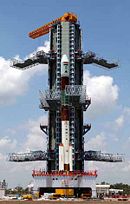
 |
| An earlier PSLV on its launch pad Source: Wikimedia |
The Indian Space Research Organisation (ISRO) created history by successfully placing ten satellites in orbit in less than 20 minutes using Polar Satellite Launch Vehicle (PSLV). The 44-metre long rocket lifted off from the second launch pad at the Satish Dhawan Space Centre at 03:53:51 GMT (09:24 local time), and reached a polar, Sun-synchronous low Earth orbit a little over seven minutes later. Following burnout of the fourth stage of the carrier rocket, the payloads were released. The PSLV flew in the CA, or Core Alone, configuration, with no solid rocket boosters around the first stage.
The ten satellites aboard the rocket will be used for several purposes by a variety of organisations. The primary payload, Cartosat-2A, is a remote sensing satellite, which will be operated by the ISRO. IMS-1, also known as TWSAT, another ISRO remote sensing satellite, was the secondary payload. In addition, eight commercial payloads were flown, as part of the Nanosat Launch Service-4 and 5 programmes. There satellites were Cute 1.7+APD-2 and SEEDS-2 for the University of Tokyo, Japan, CanX-2 and CanX-6 for the University of Toronto Institute for Aerospace Studies, Canada, Delfi-C3 for the Delft University of Technology in the Netherlands, AAUSAT-II for the University of Aalborg, Denmark, COMPASS-1 for Aachen University, Germany, and RUBIN-8 for German aerospace company OHB System.
This is the 21st orbital launch of 2008, and the second to be conducted by a PSLV. It is the 13th total PSLV launch. The next PSLV launch is scheduled for either July or December, with the Chandrayaan-I spacecraft, India’s first Lunar probe.
Source: Wikinews